 The CIPD’s social media conference has kicked off with a session from Bill Parsons, EVP HR at ARM Holdings. I met Bill at ARM in Cambridge earlier this year, so this post is a combination of his presentation, and my earlier notes.
The CIPD’s social media conference has kicked off with a session from Bill Parsons, EVP HR at ARM Holdings. I met Bill at ARM in Cambridge earlier this year, so this post is a combination of his presentation, and my earlier notes.
I’ll start off by saying ARM is one of my favourite companies – and in fact it’s one of the world’s favourite companies too. ARM’s vision is to be an effective innovative company (not just a wacky one) – a creative productive machine – and it has been consistently judged as one of the most innovative companies in the world.
However the reason I like the company is that it’s one of the very few that I know about which isn’t just using social media, but has focused on becoming a truly social organisation. Rather than following ‘the Chelsea Model’ of simply having the very best people / access to the best human capital (‘human capital is about a group of smart people who don’t talk to each other’), ARM focuses on the best social capital – ie having the best networks, relationships and trust. Human, social and intellectual capital (the explicit stuff which they sell) are the company’s differentiation. Social capital has been at the centre of their HR strategy for the last decade – it’s the rocket fuel of the innovative organisation.

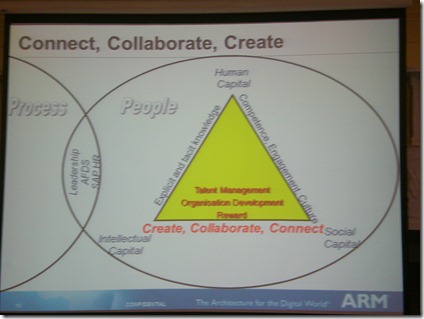
This starts with the company’s values which focus on things like teaming and selflessness (unusual in such a profitable company) – and are definitely not vanilla. They were developed and evolved from the organisation’s founders and focus specifically on ARM as a unique organisation (rather than the things which every other organisation does).
Part of the reason that ARM focuses so much on social relationships is that their strategy is about connecting, collaborating and hence innovating and their model for innovation is primarily about open innovation. They therefore need everyone to behave selflessly – for the greater good of ARM - in external as well as internal networks. It sounds idealistic but Bill says this really works at ARM (and I think I believe him).
It’s an unusual business model – ARM sees itself as being at the centre of an ecosystem of 500 competing companies collaborating. ARM itself only employees 2100 people – vs Intel, its main competitor, with 100,000 people. Their model only works by having a high surface area which it achieves by having its employees talking directly to customers. The company’s values and culture makes this easy – it’s clear what provides value.
These values are then used as the basis for HR practices eg assessing promotability, fast tracking etc. In fact the whole HR strategy is about creating the magical ingredients supporting the development of social capital. Eg rather than the Accenture corporate model in which people are fighting to get to the top, in ARM if anyone is seen to be overtly trying to be promoted, ARM will fire them! Rewards come to people who do things for the greater good.
So ARM does identify high flyer potential management talent and provides them with coaching and training to help them build their legitimacy. If you don’t have the buy-in and support of your peers and the people you’re going to manage you’ve got a problem. ARM ensures that these individuals have good business relationships and networks.
Compensation aligns with ARM’s social strategy as well. Ensuring justice is an essential part of a social strategy and ARM provide their staff with more equity than any other European company. This makes employees’ feeling of ownership more meaningful too. The corporate bonus is largely collective too (just a small proportion is individually driven).
Recognition also focuses on what people do together – they hardly ever celebrate individual success. Eg the company celebrated its 20 year anniversary last year (its been the highest performing company in the world over this time). But the celebration was really one of international collective being eg they gave everyone an ipad (they were founded as a child of Apple and Newton Computer). It was a 27 hour global party revisiting their global successes – not individual stories.
Leadership selection and development is aligned with the values too. Their CEO is probably the most understated CEO in the FTSE – the one with the highest humility. He works full time at ARM and keeps a low profile outside.
More generally ARM seek to grow leadership internally – ensuring cultural fit, and fit into the team based environment. Their feedback and development system also focuses on the company’s values, providing 180 degree insight about what employees think of their bosses.
Social media does have a role in all of this of course, in fact they’ve been using social media for at least ten years. This includes Skype, Linkedin and Facebook for external use, and blogs and forums internally. In addition, it uses:
- Internal YouTube – ARM TV
- Yammer has taken off in a big way.
- Video conferencing is the norm (rather than something which would be perceived to be not quite as good.)
- And wikis are the predominant tool for collaboration.

They also run a Exec Q&A once a year in which their exec answer any question on anything from anyone. And it’s videod and podcasted so that everyone can see it.
Interestingly a lot of this, eg Yammer and their wikis, were started unofficially and took off from there, rather than being introduced by IT.
However, in Bill’s view, social media can become antisocial media – a barrier to effective communication. So you need to do face-to-face meetings to help people get to know each other. Arguably in advance of social media.
So in ARM, traditional communications plays a part as well eg ARM run twice the number of events (with a corresponding impact on travel budgets) than they need to – these are overtly opportunities to create social networks. Eg they have a 80 person forum in which they invite people who don’t know each other well to get together (some of which is done unconference style) to work on a range of OD topics eg on the organisation of the future. This ensures the organisation is constantly questioning its culture. To get round the biggest organisational barrier of any organisation which is not having the best ideas, they often invite internal customers along, and sometimes external customers too.
It all starts with dinner and drinks in the bar, and then the next morning a discussion on the topics – but what matters is the relationships and new networks that are formed. The same in their engineering conferences, code tests, transistor tests etc etc.
ARM have tried to measure their social capital through approaches like social network analysis, and they also measure engagement, though what they’re really concerned about is organisational citizenship behaviours – do staff understand that networking is part of their day job, and that they need to help the organisation rather than just doing their own thing.
It’s an impressive case study and it’s paid off too. ARM’s market value is £4m per employee which Bill argues is down largely to the company’s social capital and use of social media.
- Consulting - Research - Speaking - Training - Writing
- Strategy - Talent - Engagement - Change and OD
- Contact me to create more value for your business
- jon [dot] ingham [at] strategic [dash] hcm [dot] com
.
 If you want to know more about innovation in HR eg developing some innovative activities in 2012, or just improving your / your team’s ‘HR innovator and integrator competency, perhaps implementing some of Vance’s suggestions, or setting up an internal HR app store, then join me for this webinar on Thursday, 12th January 12 2012 at 4:00 PM - 5:00 PM GMT.
If you want to know more about innovation in HR eg developing some innovative activities in 2012, or just improving your / your team’s ‘HR innovator and integrator competency, perhaps implementing some of Vance’s suggestions, or setting up an internal HR app store, then join me for this webinar on Thursday, 12th January 12 2012 at 4:00 PM - 5:00 PM GMT.




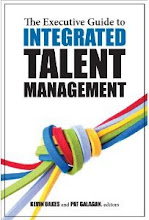










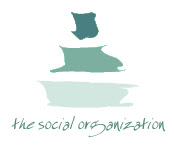
 Dave Ulrich’s latest update to the global HR competency framework was announced last week. I’ve been using and talking about the various iterations of this framework for about 15 years now and on first look, it’s my favourite list so far.
Dave Ulrich’s latest update to the global HR competency framework was announced last week. I’ve been using and talking about the various iterations of this framework for about 15 years now and on first look, it’s my favourite list so far.

 I presented a session on the future of strategic HRM yesterday. Now I’m no futurist – I much prefer to focus on the opportunities that are available to us today, but I think I’ve got a good idea of some of the changes we’ll see happening over the next 5 –10 years (I’m not going to repeat them here – just have a scan through this blog).
I presented a session on the future of strategic HRM yesterday. Now I’m no futurist – I much prefer to focus on the opportunities that are available to us today, but I think I’ve got a good idea of some of the changes we’ll see happening over the next 5 –10 years (I’m not going to repeat them here – just have a scan through this blog). As well as
As well as  I’ll be talking
I’ll be talking 



 I’ve had a couple of conversations with Michael Silverman, Unilever’s ex-head of engagement research, since meeting him at a
I’ve had a couple of conversations with Michael Silverman, Unilever’s ex-head of engagement research, since meeting him at a 


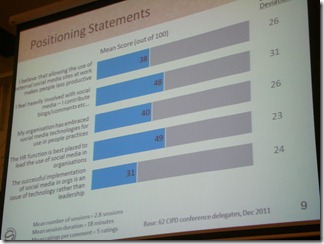





 I’ve just been attending an event with Globoforce and the Conference Board on social recognition.
I’ve just been attending an event with Globoforce and the Conference Board on social recognition. I was in South Africa for a few meetings and a workshop on HR and social media last week. It’s been a while since I’ve been to southern Africa but it was good to be back – particularly as this meant missing the news that the UK is possibly already back in recession and the announcement that austerity cuts are going to be deepened and lengthened, as well as the public sector strikes during the week (Jeremy Clarkson’s comments on the strikers were still well reported however).
I was in South Africa for a few meetings and a workshop on HR and social media last week. It’s been a while since I’ve been to southern Africa but it was good to be back – particularly as this meant missing the news that the UK is possibly already back in recession and the announcement that austerity cuts are going to be deepened and lengthened, as well as the public sector strikes during the week (Jeremy Clarkson’s comments on the strikers were still well reported however).







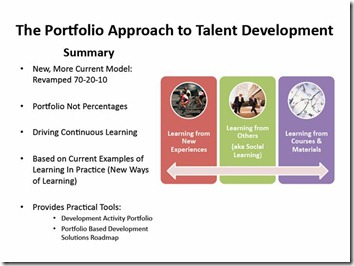

 There’s so much going on in the UK at the moment, with tomorrow’s Spending Review and Wednesday’s public sector pensions strike. And I still haven’t got around to posting on last week’s report from the High Pay Commission. But I’m out in South Africa at the moment and feel a bit cut off from these issues.
There’s so much going on in the UK at the moment, with tomorrow’s Spending Review and Wednesday’s public sector pensions strike. And I still haven’t got around to posting on last week’s report from the High Pay Commission. But I’m out in South Africa at the moment and feel a bit cut off from these issues.



 I’m at CERN today for a session that their head of recruitment, James Purvis (in the picture, sitting in the middle) has put together. The session is on recruitment and sourcing, not just on social recruiting, but that’s been the main focus this morning. There’s over 50 people here (over 30 who didn’t get squeezed in) and more people (from over 40 countries) watching on live streaming.
I’m at CERN today for a session that their head of recruitment, James Purvis (in the picture, sitting in the middle) has put together. The session is on recruitment and sourcing, not just on social recruiting, but that’s been the main focus this morning. There’s over 50 people here (over 30 who didn’t get squeezed in) and more people (from over 40 countries) watching on live streaming.









